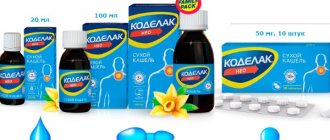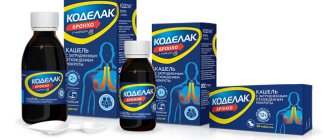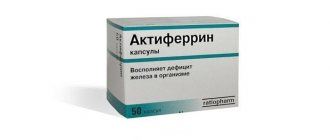Compound
Nasal spray:
- active ingredient xylometazoline hydrochloride - 0.50 mg or 1.00 mg;
- excipients: disodium edetate, sodium chloride, benzalkonium chloride, potassium dihydrogen phosphate, sodium hydrogen phosphate dodecahydrate, purified water up to 1 ml.
Nasal drops:
- active ingredient xylometazoline hydrochloride - 0.50 mg or 1.00 mg;
- excipients: benzalkonium chloride, thyrinodium edetate, monopotassium phosphate, dibasic sodium phosphate, sodium chloride, purified water up to 1 ml.
Pharmacodynamics and pharmacokinetics
The active substance of Rinostop, xylometazoline, belongs to the group of alpha-adrenergic agonists with local vasoconstrictor effects. Alpha adrenergic agonists are drugs that stimulate alpha adrenergic receptors , located in the walls of blood vessels and reacting to adrenaline , norepinephrine and other substances with a similar effect.
When applied to the mucous membrane of the nasal cavity, the drug causes a narrowing of the blood vessels located in it, but is almost not absorbed into the blood and does not have a general (systemic) effect on the human body. This helps to reduce blood flow in the veins and significantly reduce the perspiration of the liquid part of the blood through the walls of blood vessels. As a result, swelling of the mucous membrane is quickly relieved and nasal breathing is restored. The amount of nasal discharge also decreases. Eliminating swelling in the nasal cavity also improves the condition of the hearing aid.
At the same time, the drug does not have a negative effect on the mucous membrane, including its ciliated epithelium, which cleanses the nasal cavity of foreign particles. Long-term use of drops or spray (more than 5-7 days in a row) can lead to paresis of the smooth muscles of blood vessels and their prolonged dilation, accompanied by persistent swelling and nasal congestion.
The effect of the drug begins a couple of minutes immediately after it has been applied to the mucous membrane of the nasal cavity and can last for several hours.
Rinostop Extra drops naz 0.05% from 6 years 10ml N 1
Release form
Transparent colorless or yellowish solution.
10 ml
pharmachologic effect
Pharmacotherapeutic group:
Anticongestant (alpha adrenergic agonist)
Pharmacodynamics:
The cold remedy Rinostop® Extra (oxymetazoline) has a vasoconstrictor effect. When applied topically to the inflamed mucous membrane of the nasal cavity, it reduces swelling, nasal congestion, and nasal discharge, eliminating the symptoms of rhinitis. Restores nasal breathing. Elimination of swelling of the nasal mucosa helps restore aeration of the paranasal sinuses and middle ear cavity, which prevents the development of bacterial complications (sinusitis, sinusitis, otitis media). When used locally intranasally in therapeutic concentrations, it does not irritate or cause hyperemia of the nasal mucosa. The drug begins to act quickly (within a few minutes). The duration of action of Rinostop® Extra is up to 12 hours.
Pharmacokinetics:
When administered locally intranasally, the drug does not have a systemic effect. The half-life of oxymetazoline when administered intranasally is 35 hours. 2.1% of oxymetazoline is excreted by the kidneys and about 1.1% through the intestines.
Indications
— Treatment of acute respiratory diseases accompanied by rhinitis (runny nose);
- allergic rhinitis;
- vasomotor rhinitis;
- to facilitate the outflow of discharge from the paranasal sinuses in case of sinusitis, eustachitis, otitis media;
— to eliminate swelling before diagnostic manipulations in the nasal passages.
Contraindications
— Atrophic rhinitis;
- hypersensitivity to the components of the drug;
- angle-closure glaucoma;
— condition after transsphenoidal hypophysectomy;
— surgical interventions on the dura mater (in history);
- children under 1 year of age - for drops 0.025%;
- children under 6 years of age - for drops 0.05%.
You should adhere to the recommended concentrations of the drug intended for different age categories (see methods of use).
Carefully:
In patients taking monoamine oxidase inhibitors (MAO) and other drugs that increase blood pressure (including for up to 14 days after their discontinuation); in patients with concomitant severe forms of cardiovascular diseases (arterial hypertension, coronary heart disease, chronic heart failure, tachycardia, arrhythmias); with hyperthyroidism, diabetes mellitus, pheochromocytoma, prostatic hyperplasia with clinical manifestations (urinary retention), severe atherosclerosis, porphyria, during pregnancy and breastfeeding, with increased intraocular pressure, chronic renal failure, in patients taking tricyclic antidepressants and bromocriptine, as well as other drugs that increase blood pressure.
If you have one or more of the diseases and conditions listed above, you should consult your doctor before starting to take the drug.
Use during pregnancy and breastfeeding
When used during pregnancy or breastfeeding, do not exceed the recommended dose. The drug can only be used in cases where the potential benefit to the mother outweighs the potential risk to the fetus and child.
special instructions
Long-term use and overdose of the drug should be avoided, especially in children.
Avoid contact of the drug with the eyes.
To avoid the spread of infection, it is necessary to use the drug individually.
Impact on the ability to drive vehicles. Wed and fur.:
After long-term use of cold remedies containing oxymetazoline, and in doses exceeding the recommended ones, a general effect on the cardiovascular system and the central nervous system cannot be excluded. In these cases, it is recommended to be careful when driving vehicles and engaging in other potentially hazardous activities that require increased concentration and speed of psychomotor reactions.
Compound
Composition per 1 ml:
| Dosage: | |||
| 0,01% | 0,025 % | 0,05 % | |
| Active substance: | |||
| oxymetazoline hydrochloride | 0.1 mg | 0.25 mg | 0.5 mg |
| Excipients: | |||
| citric acid monohydrate | 0.6093 mg | 0.6093 mg | 0.6093 mg |
| sodium citrate dihydrate | 3.8230 mg | 3.8230 mg | 3.8230 mg |
| glycerol | 24.3480 mg | 24.3480 mg | 24.3480 mg |
| benzalkonium chloride 50% solution | 0.1000 mg | 0.1000 mg | 0.1000 mg |
| purified water | up to 1 ml | up to 1 ml | up to 1 ml |
Directions for use and doses
Intranasally.
Adults and children over 6 years of age: - apply 1 - 2 drops of a 0.05% solution in each nasal passage 2-3 times a day.
Children from 1 year to 6 years: apply 1-2 drops of 0.025% solution in each nasal passage 2-3 times a day.
Children under one year: children under 4 weeks of age - 1 drop of 0.01% solution in each nasal passage 2-3 times a day. From the 5th week of life to 1 year - 1-2 drops in each nasal passage 2-3 times a day.
Use the recommended dose for no more than 5-7 days without consulting a doctor. If symptoms worsen or improvement does not occur within 3 days, you should consult your doctor.
Side effects
Burning or dryness of the mucous membranes of the nasal cavity, dryness of the mucous membranes of the mouth and throat; sneezing; an increase in the volume of secretions released from the nose; nose bleed; after the effect of the drug wears off, a feeling of nasal congestion (reactive hyperemia).
Side effects caused by the systemic effect of the drug (in case of accidental ingestion of the solution): increased blood pressure, headache,
dizziness, palpitations, tachycardia, restlessness, anxiety, fatigue, drowsiness, sedation, irritability, sleep disturbance (in children), nausea, insomnia, exanthema, hallucinations, Quincke's edema, itching, convulsions, respiratory arrest (in infants). Visual impairment (if in contact with eyes).
Long-term continuous use of vasoconstrictor drugs can lead to tachyphylaxis, atrophy of the nasal mucosa and recurrent swelling of the nasal mucosa (rhinitis medicamentosa).
If any of the side effects indicated in the instructions or other side effects not listed in the instructions occur, consult your doctor.
Drug interactions
Slows down the absorption of local anesthetic drugs (prolongs their effect during superficial anesthesia).
Concomitant use of other vasoconstrictor drugs increases the risk of side effects.
With simultaneous use of MAO inhibitors (including the period within 14 days after their discontinuation), tricyclic antidepressants and bromocriptine, there is a risk of increased blood pressure.
Overdose
If the drug is accidentally ingested or overdose, the following symptoms may appear: anxiety, restlessness, hallucinations, convulsions, decreased body temperature, lethargy, drowsiness, coma, constriction or dilation of the pupils, fever, sweating, pallor, cyanosis, palpitations, bradycardia, arrhythmia, cardiac arrest, increased blood pressure, decreased blood pressure, nausea, vomiting, respiratory depression, respiratory arrest.
Treatment: gastric lavage, taking activated carbon; symptomatic.
Storage conditions
Store at a temperature not exceeding 25 °C.
Keep out of the reach of children.
Store in original packaging.
Indications for use of Rinostop
The drug is used:
- with nasal congestion and runny nose against the background of acute respiratory disease ;
- for chronic, including allergic rhinitis, accompanied by nasal congestion in short courses;
- for acute and chronic sinusitis ( sinusitis , sinusitis ), accompanied by nasal congestion in short courses;
- for acute and chronic otitis media to relieve swelling of the auditory tube connecting the middle ear to the nasopharynx;
- when conducting diagnostic studies (for example, rhinoscopy ) of ENT organs.
special instructions
Rinostop should not be used in long courses (longer than 1 week), for example, in the treatment of chronic rhinitis.
You must be careful not to get the solution into your eyes (it has a negative effect on vision).
When using the drug for more than 7 days, renewed nasal congestion may occur.
It is necessary to refrain from driving vehicles and operating other complex mechanisms if systemic adverse reactions develop (increased blood pressure, headache, blurred vision).
Contraindications for the use of Rinostop
The medicine is contraindicated in:
- glaucoma;
- chronic atrophic (with a decrease in the volume of the mucous membrane) runny nose;
- high blood pressure;
- tachycardia;
- hypersensitivity to the components of the drug;
- while prescribing certain medications for the treatment of depression ( MAO inhibitors and tricyclic antidepressants );
- after surgery on the meninges;
- children under 2 years old.
Vasoconstrictor drops and spray should be used with caution when:
- diabetes mellitus;
- hyperthyroidism
- severe atherosclerosis , complicated by coronary heart disease ;
- prostatic hyperplasia;
- breastfeeding the baby.
Overdose
If the drug is accidentally ingested or overdose, the following symptoms may appear: anxiety, restlessness, hallucinations, convulsions, decreased body temperature, lethargy, drowsiness, coma, constriction or dilation of the pupils, fever, sweating, pallor, cyanosis, palpitations, bradycardia, arrhythmia, cardiac arrest, increased blood pressure, decreased blood pressure, nausea, vomiting, respiratory depression, respiratory arrest. Treatment: gastric lavage, taking activated carbon; symptomatic.
Side effects of Rinostop
Side effects occur mainly with overdose, long-term (more than 5 days in a row) use, or if there are contraindications for the use of this drug. , dry nose , burning , sneezing most often appear , and sometimes the runny nose worsens.
Less commonly, with long-term use, side effects manifest themselves in the form of a sharp dilation of the blood vessels of the nasal mucosa, which is accompanied by swelling of the mucous membrane, nasal congestion and heavy discharge and disturbances in nasal breathing.
In addition, with prolonged use of drops and spray without interruption, mood changes in the form of depression may occur.
Instructions for Rinostop
0.1% spray is used for adults and children over 6 years of age. The spray is sprayed after removing the cap from the bottle. The sprayer is inserted into one nasal passage, after which the base is pressed and the drug is applied for a second. Then the spray is introduced into the second nasal passage and the manipulation is repeated. You can repeat the procedure no more than 3–4 times a day. Instructions for the use of Rinostop in the form of a spray for children 2–6 years old include the administration of 0.05% spray no more than three times a day.
0.1% nasal drops are also used for adults and children over 6 years of age, 1–2 drops in each nasal passage no more than three times a day. 0.05% children's Rinostop is administered 1 - 2 drops into each nasal passage no more than twice a day.
Rinostop's analogs
Level 4 ATX code matches:
Xymelin Eco
Xymelin
Nazivin
Galazolin
Lazorin
Nazivin Sensitive for children
Otrivin
Naphthyzin
Sanorin
Knoxprey
For the nose
Lazolvan Rino
Afrin
Rhinorus
Eucazoline Aqua
Rinazolin
Grippostad Reno
Farmazolin
Xylometazoline
Nazol Advance
Analogues are drugs from different drug groups that are used to treat the same diseases. Analogues of Rinostop - drugs that relieve swelling of the nasal mucosa: naphazoline ( Naphthyzin , Sanorin ), Oxymetazoline ( Nazivin , Nazol , Knox-spray ), phenylephrine ( Nazol Baby ), tetrizoline ( Tetrin ), tramazolin ( Lazolvan Rino ), dimethindene + phenylephrine.
Rinostop price
Rinostop price in Moscow:
- Rinostop nasal drops 0.1% and 0.05% 10 ml - 21 - 25 rubles;
- nasal spray 0.1% And 0.05% 15 ml - 56 - 65 rubles.
Rinostop tablets, produced by the pharmaceutical company Bosnalek (Bosnia and Herzegovina) are not synonymous with Rinostop drops and spray, as they have a different composition.
- Online pharmacies in RussiaRussia
ZdravCity
- Rinostop Aqua Norm for runny nose 3+, nasal spray, 100% sea water 125 mlLaboratuar De La Mer
291 rub.order - Rinostop for runny nose 6+, nasal spray, xylometazoline 0.1% 15 mlPharmstandard-Leksredstva OJSC
106 rub. order
- Rinostop for runny nose 2+, nasal spray, xylometazoline 0.05% 15 mlPharmstandard-Leksredstva OJSC
94 RUR order
- Rhinostop nasal drops. 0.1% 10ml ZAO LEKKO/Pharmstandard
37 RUR order
- Rinostop Double relief for runny nose 6+, nasal spray + xylometazoline, 15 mlPharmstandard-Leksredstva OJSC
RUB 142 order
Release form
Rinostop drops 0.05% and 0.1% are presented as a transparent and absolutely colorless solution, which is placed in a glass or plastic bottle (10 ml) with a dropper cap.
Spray 0.05% and 0.1% have the same physical characteristics as drops. Available in plastic bottles.
Tablets for colds are white, round and placed in a blister of 10 pieces. The pack contains 1 blister.
The reddish syrup with a pronounced raspberry aroma is bottled in 100 ml bottles. A measuring container is included with the product.










